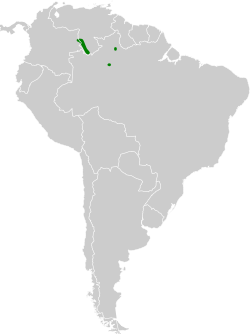Description
The Yapacana antbird is 13 to 13.5 cm (5.1 to 5.3 in) long and weighs 14 to 15 g (0.49 to 0.53 oz). Adult males have a mostly gray face. Their crown, neck, back, and rump are dark gray with a white patch between the shoulders. Their tail is blackish gray. Their wings are blackish gray with narrow white tips on the flight feathers and wing coverts. Their underparts are white with a light gray tinge on the breast, flanks, and crissum. Adult females have upperparts like the male's but without the white tips on the flight feathers and wing coverts. Their underparts are light reddish yellow-brown with a paler throat and a gray tinge on the flanks. Both sexes have a blackish maxilla, a pale mandible, and pale pinkish gray legs. Subadult males are like adults with a light reddish yellow-brown tinge on their underparts. [6] [7] [8] [4]
Behavior
Movement
The Yapacana antbird is believed to be a year-round resident throughout its range. [6]
Feeding
The Yapacana antbird feeds on arthropods, especially insects and spiders. It typically forages singly, in pairs, or in family groups and does not join mixed-species feeding flocks. It forages mostly on the ground under dense vegetation though it will feed as high as 1.5 m (5 ft) above the ground. It actively roots through ground litter in short pauses between hops and also gleans from foliage and branches while on a low perch. It occasionally attends army ant swarms to capture prey fleeing from the ants. [6] [7] [8]
Breeding
Almost nothing is known about the Yapacana antbird's breeding biology. It appears to be territorial and to breed in the wet season. [6]
 | Songs and calls
|
Vocalization
The Yapacana antbird's song is a "curious, rapid sequence of 1 or 2 almost toneless, rising gratings, immediately followed by very high 'pipip' or 'pi', the total as 'grrrrr-pipip-grrrrr-pi' ". [7] Its calls include a "single long harsh note at higher pitch" than the song, an "abrupt 'squip' ", and a "soft rattle". [6]
This page is based on this
Wikipedia article Text is available under the
CC BY-SA 4.0 license; additional terms may apply.
Images, videos and audio are available under their respective licenses.




